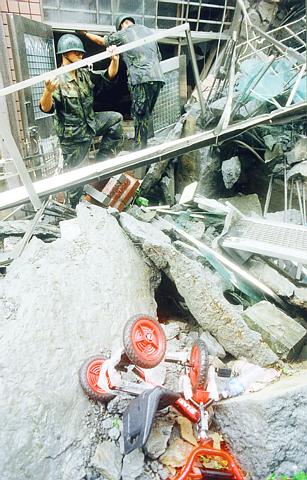Builders and government officials were given reduced sentences yesterday by the Taiwan High Court, partially reversing a lower court decision finding them responsible for the death of 28 residents at the Lincoln Mansions disaster in Taipei County.
Residents of the ill-fated buildings, who have fought for compensation since the disaster in 1997, called the ruling "incredible," and challenged the court's rulings.
"It's such an obvious and outrageous example of corruption links between the contractors and the officials. How could the court take it so lightly?" said Chou Chih-chuan (

FILE PHOTO
"Throughout the process of negotiations, we residents have been disappointed by the irresponsible attitude of the builders and the government agencies. A lot of the residents have felt so hopeless that they're on the verge of killing themselves," Chou said.
"People say the disadvantaged can have their rights protected in court. But I doubt it really," Chou said.
The Lincoln Mansions was a housing complex with over 1,000 units in Hsichih, Taipei County. Built on hillside land, the complex suffered mass damage after rain from a typhoon caused the collapse of a retaining wall behind the complex.
Twenty-eight people were killed by the collapse of several buildings and over 300 units were destroyed in the disaster. Residents of other units subsequently moved out of the complex when serious construction faults were found in the buildings after the accident.
An investigation by the prosecution found that the contractors and the designers of the complex were responsible for the accident.
Also, the investigation identified 13 Taipei County Government officials who forged documents confirming building standards in the licensing process.
The Shihlin District Court convicted 18 defendants -- five builders, one designer and twelve officials -- in 1998, while acquitting a defendant who was an official. Sentences ranged from two to 10 years prison terms.
However, the High Court reversed the lower court decision yesterday, reducing sentences for most of those convicted in the construction fault case.
The contractor for the complex, Lee Tsung-hsien (李宗賢), who was originally sentenced to 10 years and six months in jail, had his sentence reduced to four years and five months by the High Court yesterday.
The jail sentence for the designer of the residences, Lu Chung-yao (盧正堯) was reduced to eight years and six months from the original nine years and 10 months.
Moreover, the High Court found not guilty eight of the 12 previously convicted officials on the grounds of insufficient evidence. Sentences for the other guilty officials ranged from five years to seven years in jail.
Lee, the number one target of the residents' legal actions, was found guilty by the district court under charges of profiteering, falsification of documents and professional manslaughter.
However, the High Court cited a supreme court precedent in quashing Lee's profiteering charge, suggesting the charge can only be used against public servants.
An addition to the criminal proceedings, the Lincoln Mansions residents have filed civil suits against the builders and also filed requests for state compensation.
Negotiations have also continued between representatives of the residents, the builders, and the government, with meetings taking place every month.

Auckland rang in 2026 with a downtown fireworks display launched from New Zealand’s tallest structure, Sky Tower, making it the first major city to greet the new year at a celebration dampened by rain, while crowds in Taipei braved the elements to watch Taipei 101’s display. South Pacific countries are the first to bid farewell to 2025. Clocks struck midnight in Auckland, with a population of 1.7 million, 18 hours before the famous ball was to drop in New York’s Times Square. The five-minute display involved 3,500 fireworks launched from the 240m Sky Tower. Smaller community events were canceled across New Zealand’s

The Ministry of Foreign Affairs (MOFA) yesterday said it is closely monitoring developments in Venezuela, and would continue to cooperate with democratic allies and work together for regional and global security, stability, and prosperity. The remarks came after the US on Saturday launched a series of airstrikes in Venezuela and kidnapped Venezuelan President Nicolas Maduro, who was later flown to New York along with his wife. The pair face US charges related to drug trafficking and alleged cooperation with gangs designated as terrorist organizations. Maduro has denied the allegations. The ministry said that it is closely monitoring the political and economic situation

‘SLICING METHOD’: In the event of a blockade, the China Coast Guard would intercept Taiwanese ships while its navy would seek to deter foreign intervention China’s military drills around Taiwan this week signaled potential strategies to cut the nation off from energy supplies and foreign military assistance, a US think tank report said. The Chinese People’s Liberation Army (PLA) conducted what it called “Justice Mission 2025” exercises from Monday to Tuesday in five maritime zones and airspace around Taiwan, calling them a warning to “Taiwanese independence” forces. In a report released on Wednesday, the Institute for the Study of War said the exercises effectively simulated blocking shipping routes to major port cities, including Kaohsiung, Keelung and Hualien. Taiwan would be highly vulnerable under such a blockade, because it

UNRELENTING: China attempted cyberattacks on Taiwan’s critical infrastructure 2.63 million times per day last year, up from 1.23 million in 2023, the NSB said China’s cyberarmy has long engaged in cyberattacks against Taiwan’s critical infrastructure, employing diverse and evolving tactics, the National Security Bureau (NSB) said yesterday, adding that cyberattacks on critical energy infrastructure last year increased 10-fold compared with the previous year. The NSB yesterday released a report titled Analysis on China’s Cyber Threats to Taiwan’s Critical Infrastructure in 2025, outlining the number of cyberattacks, major tactics and hacker groups. Taiwan’s national intelligence community identified a large number of cybersecurity incidents last year, the bureau said in a statement. China’s cyberarmy last year launched an average of 2.63 million intrusion attempts per day targeting Taiwan’s critical